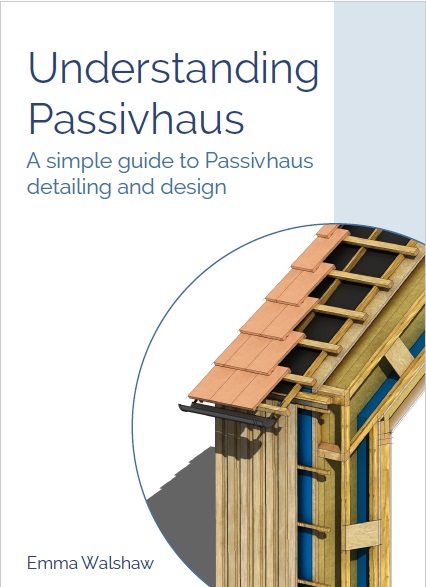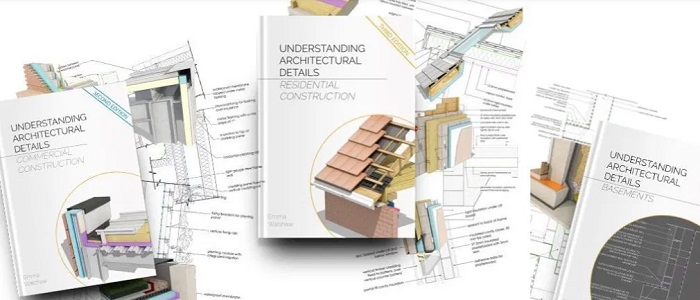Understanding Passivhaus - review

|
| 'Understanding Passivhaus – a simple guide to Passivhaus detailing and design’ by Emma Walshaw of First In Architecture. Image: Emma Walshaw |
Contents |
[edit] Introduction
Given the sometimes intense debate on global warming which dominates the media, a book purporting to improve the energy efficiency of buildings – and therefore improve their carbon footprint – must be seen as a welcome addition to any library. When that book details the principles of an established and highly acclaimed system of building simply and effectively, it deserves even more attention.
'Understanding Passivhaus – a simple guide to Passivhaus detailing and design’ is written by Emma Walshaw of First In Architecture – an on-line resource comprising guides, downloads and articles for architecture students and professionals.
Passivhaus is the low-energy design standard for buildings that are comfortable to live with minimal carbon-emissions. It is claimed to be the fastest-growing energy performance standard in the world.
Launched in 1996 by the Passivhaus Institute, Passivhaus buildings now cover residential, educational, social housing and retrofit projects. The principles have been applied on a global basis – an indication perhaps of the relative ease with which the standard can be adapted to suit local climates, materials and methods of construction.
In the introduction, Walshaw sets out the broad-brush principles of the book:
- It focusses on residential Passivhaus.
- It attempts to be as accessible as possible – an admirable aim given the potential complexity of the subject.
- Standards in the book are based on UK-climate conditions.
Demonstrating the clarity and simplicity of layout that is to follow, the book is divided into two broad sections: details and case-studies.

|
| Image courtesy of Emma Walshaw. |
[edit] Details
In the first section ‘Detail’, the reader is taken through an exhaustive explanation of the possible construction methods which can achieve the Passivhaus standard requirements. Illustrated with simple, clearly-legible diagrams, this section should be accessible even to lay people. It is an easy read – and no less rewarding for it. Indeed, much can be learned about detailing just by studying the diagrams – and this serves as an enticement into the text which is written in concise, plain English.
This section includes the certification of buildings, their components and the designers and consultants that are part of an independent process to formally assess and approve a project.
[edit] In principle
The crux of the book is the section dealing with Passivhaus principles, putting everything else into context. As with the rest of the book, this section is broken down clearly into its constituent elements:
- Building fabric
- Form Factor (how the building’s form or shape can help achieve the Passivhaus standard).
- Insulation
- Thermal bridging
- Air tightness and air leakage
- Building services and ventilation
- Windows
- Solar design
- Shading
- Summer ventilation
- Roof lights
An array of generic construction details follow which achieve the Passivhaus standard. This includes junction details for floors, walls, window heads, sills, jambs, parapets and roofs (pitched and flat) in constructions such as solid concrete, insulated concrete formwork, solid masonry, timber frame or SIPS. All are generously illustrated with sympathetically-rendered colour diagrams.
The final section of the book features case studies of finished projects which have been built according to Passivhaus standards and includes photographs, plans, sections, elevations and details. The projects depict an architecture that is stylish and sustainable, providing a comfortable home with low running costs.
Understanding Passivhaus has 140 information-packed pages – much to read and absorb. But given the topicality of the subject and the fact that it is likely to become even more critical in the coming years, the book will make a valuable addition to any construction library.
More details on Understanding Passivhaus can be found HERE.
[edit] Related articles on Designing Buildings Wiki
- An Introduction to Passive House - review.
- Code for sustainable homes
- BREEAM.
- Fabric first.
- Green deal.
- Home Quality Mark.
- Leadership in Energy and Environmental Design.
- Passive design.
- Saffron Acres, Leicester, the UK’S largest Passivhaus residential development.
- Sustainability.
- The building as climate modifier.
- Warming houses using free CO2.
- Wood and passivhaus.
- Zero carbon homes.
- Zero carbon non-domestic buildings.
[edit] External references
Featured articles and news
RTPI leader to become new CIOB Chief Executive Officer
Dr Victoria Hills MRTPI, FICE to take over after Caroline Gumble’s departure.
Social and affordable housing, a long term plan for delivery
The “Delivering a Decade of Renewal for Social and Affordable Housing” strategy sets out future path.
A change to adoptive architecture
Effects of global weather warming on architectural detailing, material choice and human interaction.
The proposed publicly owned and backed subsidiary of Homes England, to facilitate new homes.
How big is the problem and what can we do to mitigate the effects?
Overheating guidance and tools for building designers
A number of cool guides to help with the heat.
The UK's Modern Industrial Strategy: A 10 year plan
Previous consultation criticism, current key elements and general support with some persisting reservations.
Building Safety Regulator reforms
New roles, new staff and a new fast track service pave the way for a single construction regulator.
Architectural Technologist CPDs and Communications
CIAT CPD… and how you can do it!
Cooling centres and cool spaces
Managing extreme heat in cities by directing the public to places for heat stress relief and water sources.
Winter gardens: A brief history and warm variations
Extending the season with glass in different forms and terms.
Restoring Great Yarmouth's Winter Gardens
Transforming one of the least sustainable constructions imaginable.
Construction Skills Mission Board launch sector drive
Newly formed government and industry collaboration set strategy for recruiting an additional 100,000 construction workers a year.
New Architects Code comes into effect in September 2025
ARB Architects Code of Conduct and Practice available with ongoing consultation regarding guidance.
Welsh Skills Body (Medr) launches ambitious plan
The new skills body brings together funding and regulation of tertiary education and research for the devolved nation.
Paul Gandy FCIOB announced as next CIOB President
Former Tilbury Douglas CEO takes helm.
UK Infrastructure: A 10 Year Strategy. In brief with reactions
With the National Infrastructure and Service Transformation Authority (NISTA).






















